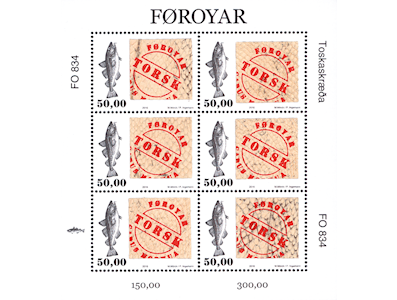| Item No. | Vørunavn | Eind | Mynd | Prísur v/MVG |
|---|

For the first time ever: Fish skin stamps - incredibly beautiful and patterned with almost metallic colour tones.
Issue Date: 9/26/2016
Item No.: PPD000834
Value: 300,00
Once in a
while assignments end on my desk that prove to be a real eye-opener. These are
creative works of art so unusual and yet so obvious that you smile, scratch your
head in amazement and exclaim: "Of course! Why did not I think of that
before? "
I had such
an experience the other day when Posta turned to me and asked if I could write
a small article about their new stamp, which - and here my eyes opened wide -
is made from cod skin.
"Cod skins,"
I thought, "how on earth does such a work of art look like?"
My faint scepticism
was quickly put to shame when I saw the stamps. They were in principle designed
as ordinary stamp with texts, values and a small shaded drawing by master
engraver Martin Mörck. But the similarity stopped right there. Onto each stamp
a square piece of tanned cod skin had been glued. It was not at all grey and
dullish, which I to my embarrassment must admit was my initial fear - but
incredibly beautiful and patterned with almost metallic colour tones, which
change depending on the angle it is viewed from. By looking at several examples
I was able to ascertain that they are all different - something the Philatelic
Department makes every effort to avoid.
Whatever
the case, in September Posta will issue beautiful stamps with skin of cod
caught in Faroese waters, supplied by fish exporter Nevið in Runavík, tanned by
Atlantic Leather in Iceland and printed by Cartor in France.
The
Atlantic cod (Gadus morhua) is usually
about one meter in length, but can grow to 2 meters and weigh up to 96 kilos.
It can reach an age of 25 years and is found on both sides of the Atlantic,
from Novaya Zemlya in the Barent Sea, Spitsbergen and Jan Mayen down to the Bay
of Biscay, in the North Sea and the Baltic Sea to the east. It is commonly
found in the waters around the Faroe Islands and Iceland, as well as Greenland
- and from Labrador in the north to North Carolina in the south.
Cod is
generally sandy brown, its back and sides are yellowish-green, with grey or
brown spots and a white lateral stripe running along its sides. The belly is
white or greyish-white. However, it can have other colour variations depending
on habitat, f. ex. dark brown or maroon if it lives among kelp.
Cod is
popular for its delicate flesh. This is especially true of Faroese cod, which is
fatter and not as mealy or dry as cod in other places.
Tanning of
fish skin an ancient art although it has not been common in the post-war
period. The quality of fish leather will of course vary from species to species,
but properly treated skin of cod, salmon and lumpfish is often stronger than
ordinary cowhide.
The size of
fish skins have made them especially well-suited for producing smaller items,
such as shoes, bags, purses and
watchbands. Sewn together, they can also be used in the garment industry and to
upholster furniture. Today's designers are getting more and more aware of fish
skins‘ practicality and beauty - and use them, in addition to the items mentioned
above, for a number of few articles, f. ex. jewellery, belts, book binding and
photo collages.
There is a
growing tendency to make the fullest use of fish being caught which means that
in the coming decades we will no doubt see an increased use of fish skin for
various purposes. It will not be limited to tanning of fish skin, but will occur
over a broader spectrum - in the industrial production of fish gelatine, which
can be used both in the food industry, as well as in advanced technology such
as electronics and optics. In addition, fish skin protein can be used in the
nutrition industry and as health food.
The uses of
the Faroe most abundant material, fish, can only be limited by our imagination.
And right now Posta strikes a blow for the forgotten treasure found in the
versatile uses of fish products by issuing unique stamps with the most fascinating
cod skin patterns.
Anker Eli
Petersen







